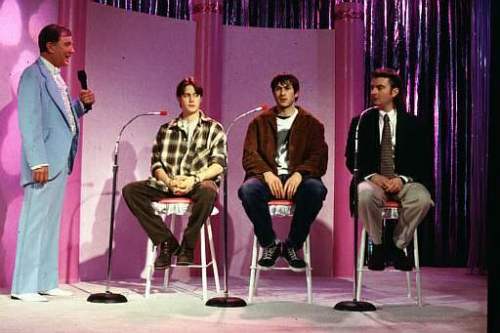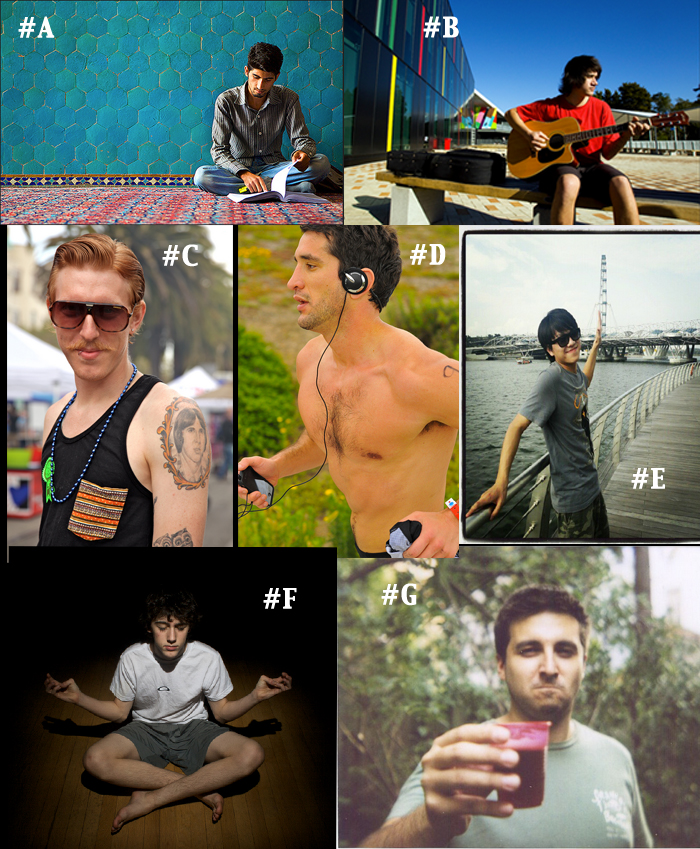You are here
Ethos and Online Dating 2.0 - Incorporating Visuals
Primary tabs

Image from The Dating Game scene in Mallrats. Found on The Baltimore Chop website.
A remix of a previous lesson plan, this exercise asks students to analyze the ethos of an online dating profile and then pair it with an appropriate image - drawing on the relationship between written and visual rhetoric.
This works as a great introduction to the concepts of ethos, audience, and/or visual rhetoric.
In theory, you could do this assignment without classroom technology, though an internet connection and projector would be ideal.
This is an update on a previous lesson plan: Teaching Ethos Using Online Dating Profiles, which relies strictly on textual analysis. As I explain in that plan, "Perhaps more so than any other piece of writing, and even more so than my students' facebook pages, the self-summaries presented in online dating profiles are fundamentally arguments of ethos. Regardless of specific rhetorical aim (a casual hook up, a future spouse, or something in between), at heart, each of these texts is saying to readers, 'this is who I am, accept me.' So they seemed like a great source text to get my students really thinking about how and why they evaluate people: what sort of snap judgements they make, how they read into things without even realizing it."
In this version (re-designed for my Introduction to Visual Rhetoric course this semester), I ask students to draw connections between written ethos/self-presentation and pieces of visual rhetoric. I offer them a written profile alongside a series of pictures of eligible "bachelors" to choose from. They then had to make the case for why they thought a particular image fit the written profile.
For this specific class, we had just begun a unit on style, and my students had been reading excerpts from Barry Brummett's A Rhetoric of Style and Stuart Ewan's All Consuming Images. Our discussion, therefore, focused a lot on the stylistic choices in the images and how those might be read as reflections of particular values indicated in the written profile. While those readings and that framework aren't necessary for this exercise, they did help to get my students grounded in the way they read people's visual style. Without this kind of foregrounding, you may end up having to do a fair bit of extra wrangling to get students to articulate why they draw the conclusions they do (i.e. how they connect mustaches with driving a Vespa). But that can be a great discussion - forcing them to confront/explain the assumptions they make.
I spent a fair bit of time compiling a set of "bachelor" photos from creative commons liscenced images that I found on the web, rather than using people's actual OKCupid profile pictures. I'd recommend just using the ones I've put together (see below), though you're welcome to make your own. The idea of using actual images from OKCupid profiles didn't sit well with me, even if they are publicly available. It seems like an invasion of privacy (in a way), or at least a kind of appropriation that I'm not comfortable with. The written profile I excerpted was previously a public page but has since been taken down/made private - which means if you have students do this as a homework assignment or on computers, they can't just google some key phrases to find the actual profile (one of the downfalls of the previous lesson plan).
I tried to compile a diversity of styles that nevertheless might fit with the written profile, as well as some that I thought clearly didn't fit. However, I was surprised by my students' responses. There were multiple votes for five of the seven images - a much wider range than I anticipated.
In our introduction to the concept of style, we also talked about the idea of "ethos" - the character, or sense of authority, that one presents to the world, either through writing (as you may have addressed in previous rhetoric courses) or (for our purposes) through style.
This unit is all about thinking through the assumptions we make about, or (more kindly) ways in which we read, both the styles of others and our own styles. What we think of a particular style or clothing item isn't necessarily the same as how others view it.
There is, perhaps, no clearer instance of an argument based on character (and style) than online dating profiles. Each person's profile essentially makes the argument that "you should date me because of who I am." These arguments are paired with a selection of images, presumably chosen to cast the author in his or her most favorable light. On the free online dating site OkCupid, users combine images of themselves with written self-summaries in order to convince potential matches to give them a chance.
For this exercise, read over the written dating profile below, and then review the potential images. Your task will be to pair the written profile with one of the possible images. We'll assume that all elements of the image were carefully crafted/selected for this particular purpose/venue.
Questions to consider in making your choice: What kind of person does this profile describe? What does he value/care about? Which image do you think best reflects those values or that style?
Write a few sentences explaining your choice. Be sure to offer evidence for your analysis. Why does this image/person seem most fitting to you? What kinds of things about the man's style do you infer from the image? How, specifically, does that connect with the written description? You might also include your rationale for eliminating other potential options.
Keep in mind that you want to think about the "big picture" of this profile. While one or two aspects of the written part might point toward a particular image, is that image wholly congruent with the rest of the profile?
The Written Profile:
I have a yearning to explore different territory. To frolic in a refreshing mist atop the Yellow Mountains of Mainland China. To play with other great musicians. To watch shows in the opera house of Lyon, with an intermission of French kids break dancing outside the hall. To cook my own recipe in a Paul Bocuse culinary. These are things that most of my homies won't touch. Lest we forget, I am an abnormal guy; and I am looking for an extraordinary girl.
I want a girl who can be fun and adventurous. The kind of girl who isn't too afraid to suddenly break out of a three-day isolation and take a road trip across the country on a 1987 Vespa which I am convinced can take at least another hundred thousand miles.
Interestingly, my most passionate relationships involved completely contradictory personalities. Speaking of character--unfortunately, not all of us can be satisfied with pixellated photos and interview format autobiographies. Call me old-school, but coffee and a heated intellectual conversation beats the hell out of a 9 day back and forth email chat marathon. If you want to get to know me, call me. Tell me about yourself. Talk to me about politics. What is really important to you? I never get tired of meeting new and inherently good people.
The Potential Bachelors:
Image Credits:
#A - twocentsworth. "Studious." Flickr.com. 3 June 2008.
#B - Mosborne01. "Ashs-student-playing-guitar." Wikimedia Commons. 1 July 2010.
#C - torbakhopper. "Cool Dude." Wikimedia Commons. 10 Nov 2011.
#D - Chris Hunkeler. "Running with Music." Flickr.com. 5 May 2013.
#E - siuhonglo. "Singapore Flyer." Flickr.com. Aug 27 2011.
#F - connerdowney. "7 - Meditation." Flickr.com. 08 Jan 2009.
#G - sadly, I have lost the citation information for this one. I know it was CC licensed, though. I will post citation if I can find it again.
This was in in-class exercise, so it wasn't evaluated.
My students really enjoyed the exercise, and I was surprised by the arguments they made for one image over another. It fostered a lively conversation about stereotypes and assumptions (particularly the way they read the image of bachelor #C).
RHE 315 - Introduction to Visual Rhetoric
With the rise of new media and network television, Americans are exposed to thousands upon thousands of images on a daily basis. From our facebook streams to our television viewing choices to our personal email accounts, we are bombarded with images: of celebrities, of politicians, of consumer goods, of natural disasters, of… cats. And we must filter through it all in order to make sense of our world.
In this course we will explore the ways in which images can be read, analyzed, constructed, and manipulated. We will interrogate how images inform our reading of historical and political events, of personal identity, of public and private spaces. We will think through issues of self-presentation: how our stylistic choices convey messages to the world around us, and how we interpret the choices of others. We will look at the spaces we frequent and consider the rhetorical effects of everything from the architecture to the furniture to lighting. In short, we will investigate how the visual (non-linguistic, non-textual) world conveys its messages.
-

- Log in to post comments


